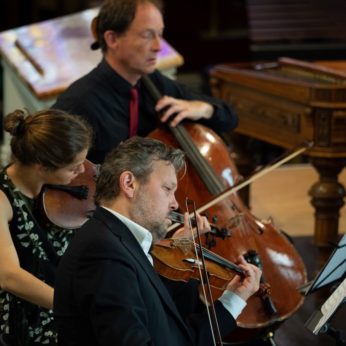Composer: Ludwig van Beethoven (b. 1770 - d. 1827)
Performance date: 08/07/2018
Venue: St. Brendan’s Church
Composition Year: 1799
Duration: 00:41:12
Recording Engineer: Ciaran Cullen, RTÉ
Instrumentation Category:Septet
Instrumentation Other: vn, va, vc, db, cl, hn, bn
Artists:
Bram Van Sambeek -
[bassoon]
Ron Schaaper -
[horn]
Annelien Van Wauwe -
[clarinet]
Niek de Groot -
[double bass]
Christopher Marwood -
[cello]
Dana Zemtsov -
[viola]
Andreas Reiner -
[violin]

Andreas Reiner [violin], Dana Zemtsov [viola], Christopher Marwood [cello]
Niek de Groot [double bass], Annelien Van Wauwe [clarinet]
Ron Schaaper [horn], Bram van Sambeek [bassoon]
Ludwig van Beethoven [1770-1827]
Septet in E flat Op.20 [1799]
1. Adagio – Allegro con brio
2. Adagio cantabile
3. Tempo di Menuetto
4. Tema con Variaziono : Andante
5. Scherzo : Allegro molto e vivace
6. Andante con moto alla Marcia – Presto
Infinitely richer in genuine beauties than many of his later works, for example, the Grand Sonata Op.106, so wrote one crowd-pleasing critic in 1826, earning Beethoven’s fury and posterity’s ridicule. Another critic referred to the Septet as this especially popular, excellent piece – well known as one of the most melodious cheerful and comprehensible of Beethoven’s works. This was in 1816 after he had written eight symphonies, eleven quartets and twenty eight of the piano sonatas, so the composer’s anger at the public’s attention being focused on such an early and simple work is understandable, but, of course, it is indeed melodious and cheerful and great fun for both audience and musicians. But to mention it in the same breath as the Hammerklavier shows a breathtaking lack of taste.
The Septet belongs to the classical Divertimento tradition with its six movements and its exuberantly entertaining mood. It was premiered in Vienna at the same time as the First Symphony on 2 April 1800. The horn and the first violin share the limelight in the splendid slow introduction, before that irresistible first subject comes whirling in. The triple role of the wind is discovered early on in the movement, disporting as soloists, supporting the strings or ranging themselves antiphonally as a group or in pairs. There is infinite pleasure to be found in the interweaving of their various parts.
The Adagio cantabile explores a vein of luxuriant lyricism typical of the young Beethoven with the violin picking up on the clarinet’s romantic opening solo. The central section gives the horn a starring role, adding drama to the nocturnal romance. The return of the opening is now richly decorated as clarinet and violin alternate in arabesques of delight.
Most pianists will recognise the minuet’s old-fashioned theme, which Beethoven borrowed from his early G major Sonata, later published as Op.49/2. The trio features cavorting triplets for horn and clarinet. The variations fourth movement is based on a charmingly simple tune from a Rhenish folksong. The variations begin with the strings alone in double time followed by a dashing duet between the first violin and the clarinet and the third variation finally gives the bassoon the limelight along with the clarinet. The minor key variation is given to the melancholy horn and everyone comes together for the adagio last variation and coda. The bucolic Scherzo is led by a horn fanfare and the cellist gets his moment of glory in the Trio.
The Finale begins with a mock dramatic slow introduction before the main presto comes dashing in. There is even a cadenza for the first violin before the finale reprise so Beethoven probably had the famous Schuppanzigh in mind when he wrote the work. This was the last chamber work involving wind instruments that Beethoven found it necessary to write, thereafter he kept the wind instruments inside the orchestra.
Francis Humphrys
Copyright © 2024 West Cork Music. All rights reserved.
Designed and developed by Matrix Internet